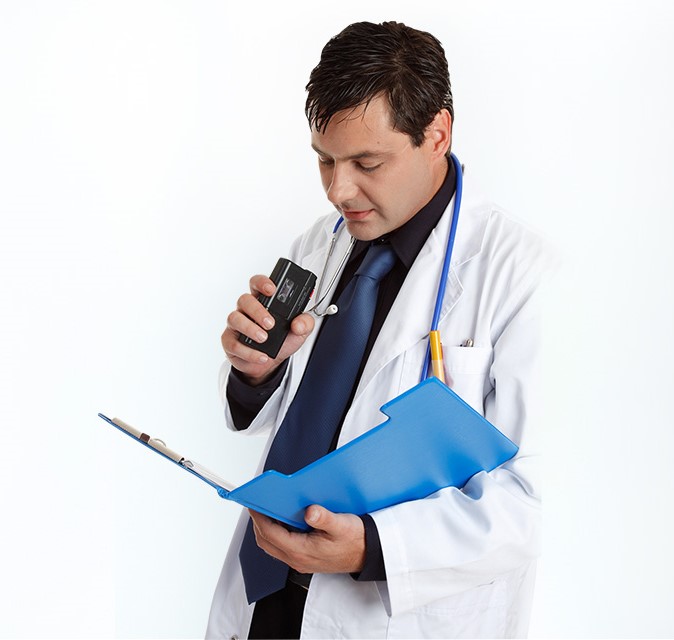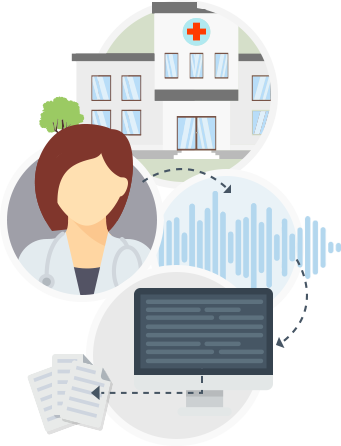Medical Transcription Clinical Document Management
Improved Efficiency, Satisfaction, Revenue And Patient Care For Health Care Professionals
Clinical Documentation Management
MDofficeManager understands how valuable your time is, and we also understand how time consuming clinical documentation can be in your EMR system. Your training is in healthcare, not typing or point-and-click processes. Hence, MDofficeManager will assist you in saving time for what matters most – patient care.
Let us take the headache of clinical documentation off of your shoulders.The cost saving will be apparent as you’re able to care for more patients, instead of more paperwork.
MDofficeManager is known nationally for providing holistic benefits, such as: Saving Time, Improved Accuracy, and promoting patient care.

Medical Transcription Services
MDofficeManager has over a decade of experience in offering a web-based document management platform that provides clients with all aspects of the documentation process through confidentiality contracts, encryption technology, & dedicated data lines.
MDofficeManager provides online accounts for physicians & staff, in order for easy access through virtually any internet accessible computer to search, review, edit, print, fax, e-sign, so as to provide seamless medical transcription services. These files, subsequent to sign- off, can be automatically uploaded to the health info systems using the latest integration options such as HL-7, or these can be manually posted by us as per your requirements.
MDofficeManager is a genuine member of the consortium with Verizon Medical Data Exchange (MMDE), and in allowing you can connect with 300,000+ physicians to interact for clinical documentation.

Extremely easy to use, training takes only about 10 minutes.
According to the provisions of the HITECH Act of 2009, organizations that were eligible for the MIPS/APM Incentive Program & could receive incentive payments. Those who failed to achieve that standard may be penalized. To receive the maximum reimbursement, physicians and hospitals must have achieved stage III of MIPS/APM for at least a 90-day period within the 2017 federal fiscal year and for the entire year thereafter.
How can MDOfficeManager help YOU to achieve this
MDofficeManager’s medical transcription services provides tools like ADT interfaces, partial dictation with Discrete Reportable Transcription (DRT), CDA documents and HL7 interfaces, etc. These tools allow providers to maintain consistency by continuing to dictate patient notes. These dictated narrative reports can be used to maintain an up-to-date problem list of current and active diagnoses, and active medications and allergy lists as structured data. This is much more efficient compared to the point-and-click boilerplate which unnecessarily consumes valuable time & attention, which can equal lost revenue. Allow MDofficeManager’s dedicated team and state of the art resources do the work for your dictated summaries and seamlessly integrate these notes into your EMR system’s forms, fields, and records.
MDOFFICEMANAGER Medical Transcription for Meaningful Use
- EMR Adoption – Providers can dictate as many always have, enabling them to be more productive.
- Quality – Providers can review E-Edit and E-Sign after dictations are transcribed. The final and completed content is delivered to their EMR.
- Full Story – Providers can spend more time with their patients.
- Increased Revenue – According to research, dictation saves an hour of a provider’s day compared to point & click with an EMR system.
- Improved Top-Line Coding– Documented encounters capture the complete, cognitive analysis of clinicians instead of by “one-size-fits-all” templates.
Are you ready to take FULL advantage of the MIPS incentive?
Partial Dictation with DRT
“Free-text narrative will often be superior to point-and-click boilerplate in accurately capturing a patient’s history and making assessments. Notes should be designed to include a patient’s discussions of uncertainties.”
Healthcare facilities are advancing towards Electronic Medical Record (EMR) and Meaningful Use goals. Clinical documentation via narrative notes may change to a great extent. When it comes to the area of clinical documentation, the jury seems to be still out on which modality is the best, the most cost effective, most time-effective, and best for overall patient care.
According to a recent EMR study, Point-and-Click takes about 4.5 minutes to generate a simple note, whereas with dictation, it takes only 1.5 minutes to generate the same note. Additionally, EMR processes tend to alter the provider’s exam room interaction with patients to unacceptable levels.
What is the solution utilizing an EMR system and still maintain physician-to-patient contact while completing patients’ notes for MIPS/APM?
The partial dictation technique allows healthcare providers to use functionality within an EMR to generate some sections of the patient note while dictating other sections. These note fragments or partial dictations are then sent for transcription. Upon completion, the transcribed notes populate the patient’s electronic chart through a seamless interface in the way of discrete reportable transcription (DRT).
With most of the patient notes entered via EMR templates, the amount of audio that goes to transcription is greatly reduced. This, in turn, reduces transcription costs. At the same time, physicians are given the option to dictate critical aspects of the encounter, which allows them to do it more quickly and with greater detail. The end result would be a hybrid model that combines the power of the EMR with the time and cost efficiency of dictation.
Back-End Speech Recognition
MDOfficeManager uses Back-End Speech Recognition. The physicians simply have to be in their comfort zones and dictate via dictaphone, toll-free number or iPhone and Back-End Speech Recognition will do the rest.
Speech recognition promises far better accuracy, better data, and improved clinical documentation. Researchers have suggested that there are a lot of errors reported due to fatigue and boredom as a result of monotonous work. Speech Recognition is a program that has turned typists into editors, and doing investigative work compared to monotonous labor work, translating into better overall accuracy and meaningful use.
Due to the advent of speech recognition, the turnaround times have improved greatly.
MDofficeManager uses a speech recognition technology that is deeply integrated into their transcription workflow platform. MDofficeManager’s state-of-the-art speech recognition technology translates physician dictations in real-time into a searchable, structured document. The result is a meaningful clinical document that can be used by both people and systems in the care process.

